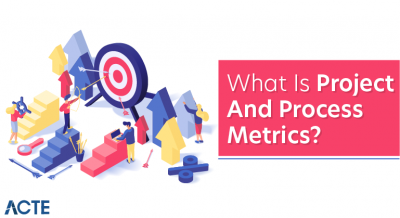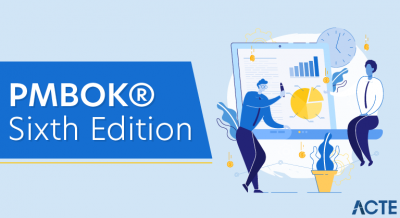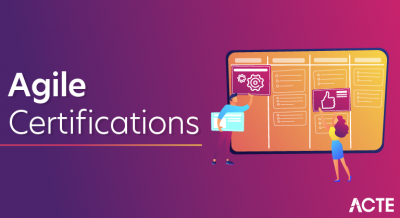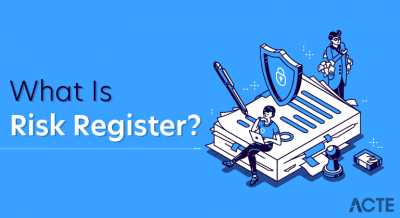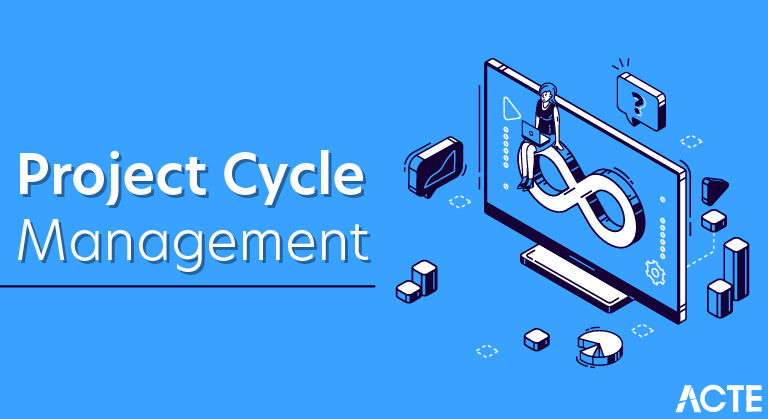
Project Cycle Management or PCM is an approach that allows you to manage many different projects and improve the quality of your projects over time. PCM uses the idea of a continuous learning cycle and incorporates logical framework analysis to guarantee that the beneficiaries are involved in the project’s design. However, PCM’s built-in flexibility is often threatened by the way its tools and models are used in a rigid way by donors and strong NGO partners.
PCM or Project Cycle Management is an approach to manage multiple projects or programmes and to improve the quality of projects by learning from one project and applying the lessons in the following ones. The approach was introduced by the World Bank in the 1980, and spread throughout the development world in the 90s, when it was picked up by the European Commission. Following an evaluation on Aid Efficiency, the EC introduced PCM as its main approach to manage and evaluate development project proposals.
Since then, other donor agencies and NGOs picked it up, although not always voluntarily. The fact that donor agencies actively pushed PCM and models and tools related to PCM led to resistance and often gave this approach a bad rep. One of the main tools of PCM, apart from the overall cycle, is the logical framework. With its emphasis on participation from both partners and beneficiaries, PCM incorporated the logical framework approach (LFA) and added two main elements:
- The link between the long term policies or the strategic framework of the organisation and their execution in the form of projects (or programmes)
- Learning from experiences: PCM puts a heavy emphasis on monitoring and evaluation. The main idea behind the cycle is that the quality of projects gradually improves as lessons are passed on from one project to the next. Also, within a single project there is flexibility and learning, as continuous monitoring allows the people who manage the project to adapt the activities and planning to the (changing) situation in the field. At least, that is the theory.
Another benefit of PCM, both from the management point of view and the quality improvement point of view, is that it presents a standardised approach with standardised tools. However, this is also the main reason why PCM meets with a lot of resistance. As a project management approach, PCM is mainly interesting for donor agencies and large NGOs. The problem is that these large organisations tend to force their partners to use the procedures and tools in a very rigid way. This goes up to the point that the emphasis shifts from flexibility in the field and learning between projects, towards respecting contracts, forms, procedures, administrative rules, budget restrictions, and so on. PCM is used to manage contracts, control projects and see to it that laws, regulations and budgetary restrictions are respected. Often, this leads to a situation where both beneficiaries and the NGO or NGOs that manage the projects are bound by hands and feet to the contract, the logframe, the budget and the planning. This is a far cry from the original notion of flexibility and learning.
The Project Cycle
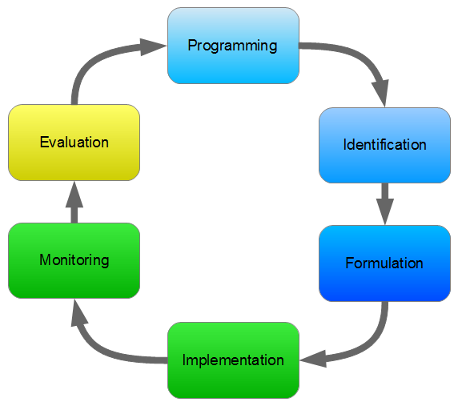
Characteristics of the phases
“Programming”
During this phase the roles of the project cycle manager(s) are:
- Organise an internal discussion on policy and strategies of both the recipient country and the donor organisation.
- Organise a participatory workshop to weigh as against to the policy objectives the different sectors and their specific problems justifying support.
- Collect evaluation findings on the sectors selected.
- Develop a strategy and criteria of how to comply with the strategy.
- Estimate a budget framework;
“Identification”
During this phase the roles of the project cycle manager(s) are:
- To verify the cohesion of the idea and the policy and strategy framework.
- To verify whether the project idea is relevant to the beneficiarie.
- To see to it that the beneficiaries are clearly specified and their perception listened to.
- To initiate and verify the quality of the identification of the real existing pressing problems and their causes.
- Assure that no pre-conceived solution is accepted without having verified the relevance to the beneficiaries.
- To launch a proper identification process if in doubt about the quality of the existing information.
- Draft the Terms of Reference for the identification process.
- If found opportune to identify and contract a moderator to guide the participatory workshop with the key stakeholders.
- Ensure the verification and incorporation of relevant lessons from evaluations (from different donors).
- To assess the pre-feasibility study document and check the presence and quality of all the required information.
- To ensure an agreement of principle on a possible project by decision makers on the choice of the project idea and the beneficiaries
“Formulation”
During this phase the roles of the project cycle manager(s) are:
- To verify whether the identification has been properly done.
- If not yet done in the previous phase, to assess the pre-feasibility study document and check the presence and quality of all the required information.
- To ensure an agreement of principle on a possible project by decision makers on the choice of the project idea and the beneficiaries.
- To formulate the Terms of Reference of the feasibility study.
- To select the team of consultants with the right technical, social, cultural, environmental, financial, economic, and managerial expertise to carry out the feasibility study and formulate the project proposal.
- To monitor the proper implementation of the feasibility study.
- To receive and assess the quality of the feasibility study and the attached project proposal (the design of the project presenting the objectives and the WHAT should be done by the project, is to be summarised in the form of a Logical Framework matrix, and the HOW the implementation is going to be organised internally by the implementing agencies is to be presented in separate Management Matrixes for each of the agencies as well as for the project management providing support to the respective agencies).
- Request for a letter of commitment from the recipient authorities and intended implementing agencies.
- To transpose the information presented in the feasibility study and attached draft project proposal into the required format of the proposal.
- Have the budget and technical design verified by external expertise.
- Present the project proposal to the decision makers.
“Implementation’’
Once funding is secured, there is nothing to stop us from executing the project (although ‘nothing’ may be too optimistic sometimes). At this step, we can start with the practical preparations of our project: recruiting additional staff; organising the project team at different levels and locations; setting up logistics and purchasing new equipment; introducing ourselves and the project to the people, the media, the local authorities, the representatives of international organisations and so on.
The monitoring and accountability system has to be put in place too. This includes the system for financial management and reporting; the system to monitor the execution and results of our activities; the administrative management system; the risk monitoring system and emergency handling system; and the planning of financial audits and (external evaluations).
At this point in time, the situation of the beneficiaries is measured before the activities start, using the indicators. This is known as the baseline, which will serve to compare the evolution of the situation of the beneficiaries to as the project progresses. However, some donors will oblige you to establish a baseline during the formulation phase and incorporate it in the project proposal. Even so, it may be a good idea to establish the situation at the very start of the project, especially when it’s been a while since the baseline was established, because other things may have influenced the beneficiaries’ situation.
The project’s planning that was established during the formulation phase may also need to be updated. It is not rare that a lot of time has passed between the development of this planning and the final approval of the project by the donor. In the meantime the situation may have drastically changed. Experience also shows that it is only now that serious reflection is given to the planning of the activities, as the project team is confronted with the reality and limitations of working in a given setting with certain resources and time available.
“Monitoring and Control’’
Monitoring and control are sometimes combined with execution because they often occur at the same time. As teams execute their project plan, they must constantly monitor their own progress.
To guarantee delivery of what was promised, teams must monitor tasks to prevent scope creep, calculate key performance indicators and track variations from allotted cost and time. This constant vigilance helps keep the project moving ahead smoothly.
“Evaluation”
During this phase the roles of the project cycle manager(s) are:
- Discuss the design of the evaluation with the implementing agencies (verification of objectives and indicators).
- Draft the Terms of Reference of the evaluation.
- Tender / contract the team of evaluators.
- Initiate the selection of national evaluators to join the team (joint evaluation).
- Identify and propose resource persons to be consulted.
- Insist on the presentation of the evaluation plan (deadlines).
- Facilitate the official introduction of the team at the recipient authorities (mandate).
- Organise intermediary meetings with the evaluation team on progress and preliminary findings.
- Monitor the execution of the evaluation with the project staff and recipient authorities.
- Insist on the delivery of draft reports and a final version.
- Initiate the preparation of a summarised “sexy version” of “lessons” for dissemination.
- Organise information sessions to have the findings of the evaluation presented to decision makers and stakeholders.
- Ensure the dissemination of the report to stakeholders.
- Ensure the recording of the findings in an evaluation data-base.


